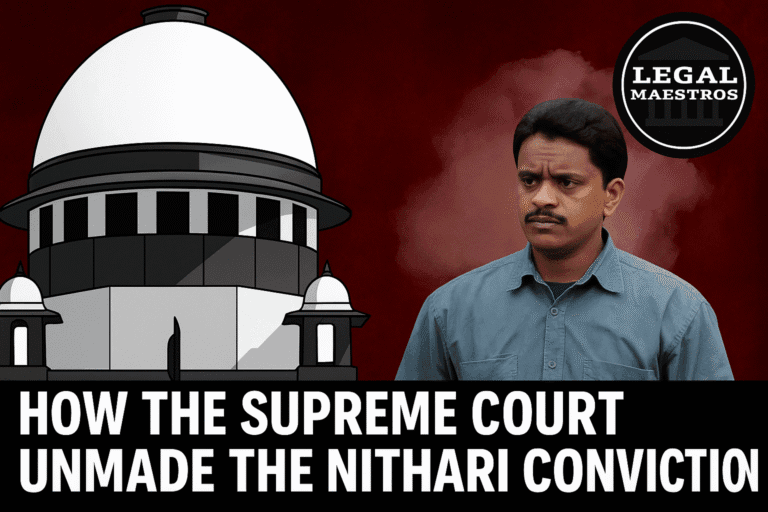
In the case of United India Insurance Co. Ltd. and Others versus M/s. Park Leather Industries Ltd., the Supreme Court of India provided clarification on a fundamental legal concept that pertains to differences of opinion regarding insurance policies in accordance with consumer protection law.
In their decision, which was handed down on April 7, 2025, Justices Sanjay Kumar and Augustine George Masih highlighted that compensation claims under an insurance policy must be evaluated based on appropriate evidence and cannot simply be approved on the basis of unilateral declarations. The dispute was sent back to the National Consumer Disputes Redressal Commission (NCDRC) so that a new assessment of the amount of compensation could be made.
Due to the fact that it emphasizes the importance of due process and evidence standards in the process of calculating insurance payouts, this case is crucial for both policyholders and insurers.
For any queries or to publish an article or post or advertisement on our platform, do call at +91 6377460764 or email us at contact@legalmaestros.com.
A Concise Review of the Situation
With United India Insurance Co. Ltd. as its insurer, Park Leather Industries Ltd., which had its headquarters in Agra, had a comprehensive insurance policy. The insurance, which covered both fire and unusual dangers, was in effect from the 30th of June in 2005 until the 29th of June in 2006.
As a result of the severe downpour that occurred on the evening of August 1, 2005, the factory shed belonging to the company collapsed, resulting in alleged damage to the company’s premises, plant, machinery, and inventories.
As a result of the occurrence, the organization submitted a claim for a sum of ₹91,000,000. A surveyor was engaged by the insurance, and the surveyor determined that the real damage was ₹8,89,176. The insurance company, on the other hand, rejected the entire claim, stating that the damage was not caused by the insured risk of “inundation,” but rather probably due to structural weakness or seepage, both of which were not covered by the policy.
For any queries or to publish an article or post or advertisement on our platform, do call at +91 6377460764 or email us at contact@legalmaestros.com.
Dissatisfied by this denial, the company lodged a complaint with the National Consumer Dispute Resolution Commission (NCDRC) in 2008, citing the Consumer Protection Act of 1986 and requesting compensation in addition to interest.
The Decision of the NCDRC
According to the decision of the NCDRC, Park Leather Industries was awarded ₹46,97,085, and the insurance company was instructed to make a payment of ₹46,97,085, in addition to 9% interest per year from the date of repudiation till the day of realization. The interest rate would escalate to 12% if the payment was not made within the allotted time frame of eight weeks.
A report that was submitted by a surveyor who was appointed by the corporation that filed the complaint served as the basis for the compensation amount. It is interesting to note that this report was only presented in conjunction with the rejoinder after the initial complaint had already been filed. Due to the fact that the insurance company had not raised any objections to this report in its written response, the Commission presumed that it had accepted the evaluation of ₹46,97,085 as being accurate.
For any queries or to publish an article or post or advertisement on our platform, do call at +91 6377460764 or email us at contact@legalmaestros.com.
Throughout the entirety of the NCDRC’s instruction on compensation, this premise served as the foundation.
Appeals to the Supreme Court of the States
In accordance with Section 23 of the Consumer Protection Act of 1986, United India Insurance submitted a civil appeal to the Supreme Court. The insurer claimed that although it did not contest the NCDRC’s determination on liability, it did object to the process that was utilized to determine the amount of compensation that was awarded.
After determining that this narrow contention had some substance, the Supreme Court decided to focus its attention solely on the question of how the NCDRC arrived at the computation of the compensation sum.
For any queries or to publish an article or post or advertisement on our platform, do call at +91 6377460764 or email us at contact@legalmaestros.com.
Consideration Given to Legal Provisions
Taking into consideration the following legal provisions, the matter was examined:
In accordance with the provisions of Section 23 of the Consumer Protection Act of 1986, a party that feels wronged has the ability to file an appeal directly with the Supreme Court against official orders issued by the NCDRC.
Section 21 of the Consumer Protection Act of 1986 gives the National Consumer Dispute Resolution Commission the authority to hear complaints that involve compensation that is greater than a particular level.
For any queries or to publish an article or post or advertisement on our platform, do call at +91 6377460764 or email us at contact@legalmaestros.com.
Principles of Evidence and Natural Justice – The central question that was being discussed in the legal community was whether or not evidence that was presented by one party late in the proceedings could be accepted without the other side being given the opportunity to oppose it.
Key Concerns That Were Addressed by the Supreme Court
Both the procedural fairness and the evidentiary soundness of the decision made by the NCDRC were the primary concerns of the Supreme Court. It was brought to the attention of the court that the NCDRC had placed complete reliance on the report that was provided by the complainant’s own surveyor. This report had not been included in the first complaint; rather, it was presented for the very first time in the response. Because of this, the insurer did not have the opportunity to properly contest the conclusions that were presented in its written statement.
In addition, the court emphasized that the NCDRC did not conduct an independent evaluation of either the surveyor’s report from the insurer or the report from the complaint about the incident. As an alternative, it assumed that the insurance had accepted the report of the complainant simply due to the fact that it had not submitted an additional reply after the response received.
For any queries or to publish an article or post or advertisement on our platform, do call at +91 6377460764 or email us at contact@legalmaestros.com.
This assumption was determined to be incorrect from a legal standpoint. The court emphasized that the determination of compensation, particularly in cases involving insurance, must be based on facts that all parties have had the opportunity to examine and contest. The failure of the NCDRC to investigate the evidence presented by both parties’ sides constituted a violation of both fair opportunity and due process.
Having a fair hearing and conducting an evaluation that is balanced
The notion that adjudicatory organizations are required to act fairly is one of the most fundamental principles that was reiterated in this case. This principle is especially relevant in consumer disputes that involve significant amounts of compensation. It has been made very clear by the Supreme Court that a party cannot be penalized for failing to react to a document to which it was never formally given the opportunity to address its concerns.
In the realm of insurance, survey reports are an extremely important component. In situations when there are two distinct reports—one from the surveyor of the insurer and one from the claimant—the tribunal is required to evaluate both of them in an objective manner. It is detrimental to the process’s integrity to accept one point of view over another without conducting any kind of analysis or offering a counterargument.
For any queries or to publish an article or post or advertisement on our platform, do call at +91 6377460764 or email us at contact@legalmaestros.com.
The instruction for reassessment issued by the Court assures that both parties will now have the opportunity to present their evidence in a fresh manner, and the NCDRC will be required to use its mind in order to arrive at a compensation number that is both reasonable and appropriate.
The Order of Remand and the Upcoming Proceedings
As a consequence of this, the Supreme Court only granted permission for the appeal to be filed about the amount of compensation. The dispute was returned back to the NCDRC with instructions to reexamine the issue after both parties were given the opportunity to present their evidence concerning the degree of the damage and the appropriate sum that is payable under the insurance policy.
In addition, the court issued an order that the amount of ₹63,60,833 that had previously been deposited by the insurance company with the Registry, which included interest, should be transferred to the NCDRC and placed in a fixed deposit. This sum will not be altered in any way until the NCDRC has reached a conclusion regarding the matter.
For any queries or to publish an article or post or advertisement on our platform, do call at +91 6377460764 or email us at contact@legalmaestros.com.
The court requested that the NCDRC give the case priority and resolve it without further delay. This was due to the fact that the case began from an occurrence that took place in 2005, and the consumer complaint was made in 2008.
A significant precedent on the fair adjudication of insurance disputes under consumer law was established by the verdict that was handed down in the case of United India Insurance Co. Ltd. vs. Park Leather Industries Ltd. In particular, it emphasizes the significance of providing both parties with an equal opportunity to submit and challenge evidence, particularly in cases seeking compensation that involve substantial amounts of money. Through a proper reevaluation that is based on merit and due process, the instruction issued by the Supreme Court guarantees that justice is not only carried out, but that it is also perceived to have been carried out.
Additionally, the case sheds light on the duties that consumer forums have when it comes to dealing with technical issues such as insurance settlements. Certain decisions that are made in a hasty or biased manner can lead to a miscarriage of justice. As a result, the verdict offers a helpful road map for future instances that include contested insurance claims.
For any queries or to publish an article or post or advertisement on our platform, do call at +91 6377460764 or email us at contact@legalmaestros.com.






![Research Assistantship @ Sahibnoor Singh Sindhu, [Remote; Stipend of Rs. 7.5k; Dec 2025 & Jan 2026]: Apply by Nov 14, 2025!](https://legalmaestros.com/wp-content/uploads/2025/11/Gemini_Generated_Image_s0k4u6s0k4u6s0k4-768x707.png)
![Karanjawala & Co Hiring Freshers for Legal Counsel [Immediate Joining; Full Time Position in Delhi]: Apply Now!](https://legalmaestros.com/wp-content/uploads/2025/11/Gemini_Generated_Image_52f8mg52f8mg52f8-768x711.png)